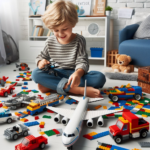Relationship Between Toys and Mental Health
The connection between toys and mental health has long been recognized, highlighting the vital role that play has always played in human development. Play is a fundamental aspect of childhood, serving not only as a source of enjoyment but also as a crucial mechanism for emotional and cognitive growth. Throughout history, various cultures have created toys that reflect their societal values, beliefs, and developmental understandings, underscoring the intertwined nature of toys and mental well-being.
Toys, in their diverse forms, encourage imaginative play which fosters creativity, problem-solving skills, and social interactions. From simple wooden blocks to sophisticated electronic games, each toy presents unique opportunities for children and adults alike to explore emotional expressions and interpersonal relationships. This progression of toys aligns with the evolving understanding of psychological development, showing how tools designed for play can spark critical life skills and emotional resilience.
The Positive Impact of Toys on Mental Health
Toys play a significant role in supporting mental health across various age groups. When appropriately utilized, they can enhance cognitive skills, foster emotional expression, and facilitate social interactions. Engaging with toys encourages imaginative play, which is instrumental in cognitive development. For instance, building blocks and puzzles help individuals, particularly children, to develop critical thinking and problem-solving abilities. These activities require focus and concentration, thus sharpening cognitive skills while also providing a sense of accomplishment upon completion.
Moreover, toys serve as effective tools for emotional expression and regulation. Dolls and action figures allow children to enact various scenarios, enabling them to process emotions and experiences in a safe environment. This form of play can also serve as a means of coping with stress or anxiety, as it offers a creative outlet for feelings that may be difficult to articulate verbally. Stress-relief toys, including stress balls and fidget spinners, are specifically designed to assist individuals of all ages in managing anxiety and promoting relaxation. These items can be particularly beneficial in high-pressure environments, such as workplaces or educational settings.
Social interactions are another significant aspect of mental health positively influenced by toys. Board games and group activities encourage cooperation, turn-taking, and communication among participants, fostering a sense of community and belonging. These interactions are vital for developing social skills and improving overall emotional well-being. In essence, the right toys can create joyful experiences, promote connection with others, and act as catalysts for personal growth and emotional stability. Therefore, integrating toys into daily routines can substantially contribute to improved mental health across various demographics.
Toys as Therapeutic Tools in Child Development
Toys play a crucial role in child development, extending beyond mere entertainment. As therapeutic tools, they facilitate emotional expression, foster social skills, and promote cognitive growth. Various studies and expert opinions highlight how particular toys aid children in processing their emotions and experiences, contributing to their overall mental well-being and developmental milestones.
One notable example involves the use of dolls and action figures in therapeutic settings. Therapists often encourage children to engage in role-playing with these toys, enabling them to project their feelings onto the figures. This practice helps children articulate their emotions in a safe environment, ultimately leading to improved emotional regulation. Furthermore, toys that require cooperation, such as board games or building sets, can effectively enhance social skills by teaching children the principles of teamwork, communication, and patience.
In a study conducted by child psychologists, it was found that children who participated in therapeutic play sessions involving toys showed significant improvement in their ability to express feelings and manage anxiety. The session included interactive games designed to encourage problem-solving and social interaction, providing positive feedback loops that reinforced their confidence and interpersonal abilities. The selected toys acted as conduits for dialogue, allowing children to navigate complex emotions that might otherwise be difficult to discuss openly.
Moreover, sensory toys, which engage children through touch, sound, and movement, have been noted for their positive impact on children with developmental disorders. These toys can help in sensory integration, promoting focus and relaxation which are essential for mental health. Experts recommend the thoughtful selection of toys in therapeutic settings to ensure they align with the specific needs of children, facilitating personalized approaches to overcoming emotional and developmental challenges.
The Dark Side: Toys That Can Negatively Affect Mental Health
The impact of toys on mental health is a nuanced topic, particularly when addressing those that can have adverse effects. Certain toys, especially those designed with violent themes, have drawn concerns from psychologists and parents alike. Research indicates that children exposed to violent toys may become desensitized to aggression, which can impact their behavior and social interactions. This desensitization can lead to an acceptance of violence as a normal means of resolving conflicts, diminishing empathy and understanding of the consequences of such actions.
Additionally, some toys reinforce unhealthy stereotypes. For instance, gendered toys that promote specific roles may limit a child’s imagination and personal growth. This confinement can lead to self-esteem issues, particularly in children who feel pressured to conform to societal or cultural norms associated with their gender. If toys consistently portray unrealistic body images or reinforce stereotypes regarding abilities, they can negatively affect how children perceive themselves and their potential.
Screen time has also emerged as a significant concern with the rise of electronic toys. While these toys can offer educational benefits, excessive use can lead to dependency on digital interactions over physical play. Long periods of screen time have been linked to various mental health issues, such as anxiety and depression, particularly when they displace meaningful interpersonal interactions or physical activities. Parents play a crucial role in monitoring toy choices and establishing limits on digital engagement, which is vital for fostering healthy mental development.
In summary, while many toys can support healthy mental health, it is essential to recognize those that may have the opposite effect. By being aware of the potential negatives and emphasizing age-appropriate selections, caregivers can make informed decisions that contribute positively to a child’s well-being.
Inclusive Toys for All Ages and Abilities
In today’s diverse society, the importance of inclusivity in toys cannot be overstated. Inclusive toys cater to individuals of all ages and abilities, allowing everyone to engage in play and foster relationships. These toys not only support development but also encourage a sense of belonging, particularly for children and adults with disabilities. When children play with inclusive toys, they learn to appreciate diversity, which can significantly contribute to their social and emotional growth.
Empathy is an essential virtue nurtured through play, and inclusive toys can facilitate the development of this important quality. For instance, toys that celebrate different cultures, races, and abilities provide an opportunity for individuals to learn about and connect with experiences outside their own. By engaging with inclusive toys, children and adults alike can cultivate empathy towards others, paving the way for a more compassionate society.
A variety of inclusive toy options are available to cater to specific needs. For children with physical disabilities, adaptive toys that are tailored to enhance motor skills and sensory experiences can be incredibly beneficial. Such toys may include specially designed building blocks or puzzles that utilize various textures and colors to enhance tactile and visual interaction. Additionally, many manufacturers are now producing toys that embrace universal design principles, ensuring that they are accessible to a wider audience.
Moreover, inclusive toys also provide opportunities for families to engage in shared experiences, strengthening familial bonds. When all members of a family, regardless of ability, can play together, it fosters inclusivity and promotes mental health across generations. By making conscious choices in their toy selections, caregivers can not only enrich the playtime experience but also positively impact the social well-being of their loved ones.
Cultural Perspectives: How Different Societies View Toys and Mental Health
The perception of toys and their impact on mental health varies significantly across cultures, influenced by historical context, societal values, and traditional practices. In many Western societies, toys are often seen primarily as tools for entertainment and education. They are integrated into early childhood development frameworks, promoting cognitive skills and social interaction. In these cultures, toys range from educational materials to technological advancements, emphasizing the developmental benefits that play provides.
Conversely, in cultures with rich traditions surrounding play, such as those in many Indigenous communities, toys often serve not only as instruments of enjoyment but also as vital vehicles for cultural transmission. Traditional toys, like handmade dolls or wooden figures, carry significance that links children to their heritage and community values. Such toys often encourage imaginative play that fosters not only creativity but also an understanding of one’s cultural identity, which plays a crucial role in mental health and well-being.
Additionally, various studies suggest that culturally significant forms of play contribute positively to mental health by allowing children to express themselves in contexts that resonate with their backgrounds. For instance, a culturally informed approach to play therapy can enhance the efficacy of therapeutic practices, helping children navigate their emotions and experiences within a cultural framework. During interviews with cultural experts, the point has often been emphasized that the societal context in which a child engages with toys profoundly influences the mental health benefits derived from play. Whether through storytelling, role-play, or communal games, toys facilitate not just entertainment but also social bonding, emotional regulation, and resilience.
This nuanced understanding of toys in relation to mental health highlights the need to consider cultural perspectives when evaluating the role of play in emotional well-being across different societies.
The Role of Parents and Caregivers in Choosing Toys
Parents and caregivers play an instrumental role in the selection of toys that can significantly impact the mental health and overall development of children. Understanding the importance of quality toy choices is essential for nurturing a child’s emotional, cognitive, and social skills. When selecting toys, adults should prioritize those that enhance creativity, encourage physical activity, and stimulate mental engagement. Toys such as building blocks, art supplies, and educational games can facilitate learning and imagination while fostering emotional resilience.
Moreover, parental involvement in play is vital for promoting a child’s mental well-being. Engaging with children during playtime helps strengthen relationships and builds trust. It allows adults to observe a child’s interests and preferences, enabling them to make informed decisions when choosing toys that align with those tendencies. A collaborative approach not only encourages a child’s independence but also provides opportunities for adults to introduce new concepts and skills in an enjoyable manner.
It is also important for parents and caregivers to moderate playtime to ensure a healthy balance. While toys can offer numerous benefits, excessive screen time or play with stimulating toys can lead to overstimulation and anxiety. Establishing clear limits on playtime can promote a balanced approach, allowing children to engage in various activities that support their mental health. Outdoor play should be encouraged alongside toy play, providing opportunities for social interaction and physical activity.
Ultimately, the choices made by parents and caregivers can significantly influence a child’s mental health. By selecting appropriate toys, engaging in play, and moderating playtime, adults can create an enriching environment that fosters healthy emotional development and encourages well-being in children of all ages.
Current Trends in Toys and Their Impact on Mental Health
In recent years, the toy industry has witnessed notable shifts driven by innovations and a greater understanding of child development and mental health. The emergence of STEM (Science, Technology, Engineering, and Mathematics) toys represents a significant trend that aims to engage young minds in critical thinking and problem-solving. By promoting skills essential for the future workforce, these toys help stimulate cognitive growth, which can have a positive impact on mental health by fostering confidence and resilience in children.
Another growing category is mindfulness toys, designed to cultivate emotional well-being and encourage relaxation. These toys, which include stress balls, fidget spinners, and sensory play items, provide calming mechanisms during moments of anxiety or overstimulation. Research indicates that mindfulness practices can lead to improvements in emotional regulation and overall mental health, making these toys vital tools for children and adults alike, especially in an increasingly stressful world.
Technological integration in toys has also surged, with options like interactive robots and augmented reality experiences becoming increasingly popular. While these tech-integrated toys provide engaging platforms for learning and play, concerns arise regarding their impact on social interactions and physical activity. Excessive screen time associated with such toys could lead to isolation and diminished mental health. Therefore, it is essential for caregivers to monitor usage and ensure a balance between tech-based play and traditional interactive experiences that foster social engagement.
In comparison, traditional toys—such as simple building blocks, dolls, or board games—continue to offer unique benefits for mental health by promoting imaginative play and social interaction. These options encourage creativity, collaboration, and deep interpersonal connections, which are crucial for developing social skills and emotional intelligence. Thus, while modern trends in the toy industry provide exciting innovations, it is vital to balance them with traditional toys that offer holistic growth opportunities for mental well-being across all ages.
Conclusion: Finding Balance in the World of Toys
Throughout our exploration of toys and their impact on mental health, it has become evident that the selection of appropriate playthings is crucial for individuals of all ages. Toys can serve as valuable resources for not only stimulating creativity and critical thinking but also for promoting emotional well-being. However, it is equally important to recognize the potential downsides that certain toys may harbor, particularly when they are associated with overly aggressive themes or excessive screen time. Thus, finding a balance in the world of toys is essential.
As we have discussed, the right toys can bolster cognitive development, enhance social skills, and provide therapeutic benefits. For young children, toys that promote role-playing and imaginative play can facilitate the development of empathy and emotional intelligence. Similarly, for adolescents and adults, engaging in hobby-related activities can help manage stress and serve as an effective outlet for creativity. On the contrary, toys designed without mindfulness can lead to adverse effects, such as increased aggression or social withdrawal, suggesting the importance of scrutinizing toy choices.
Readers are encouraged to reflect on their own toy selections, considering how these items align with the principles of promoting mental well-being. Actionable steps may include opting for educational toys that encourage problem-solving, seeking out inventive craft kits, or prioritizing interactive experiences that foster social connections. Additionally, by engaging in play alongside younger generations, adults can enhance relationships while modeling healthy play patterns.
Ultimately, awareness and intention should guide the choices we make regarding toys. By consciously selecting age-appropriate and psychologically supportive toys, we can positively influence mental health outcomes, making play a nurturing element of our lives for all ages.
SUMMARY
The Good: How Toys Benefit Mental Health
1. Stress Relief & Emotional Comfort
- For kids: Plush toys and dolls offer emotional security.
- For teens/adults: Weighted plushies, fidget spinners, and sensory kits help reduce anxiety.
- For seniors: Nostalgic toys bring comfort and joy.
2. Cognitive Stimulation
- Puzzles, building blocks, and STEM kits encourage problem-solving and keep the mind active at any age.
- Senior benefits: Delays cognitive decline, stimulates memory recall.
3. Social Connection
- Board games, multiplayer video games, and collaborative building sets encourage socialization.
- Helps combat loneliness in seniors and builds teamwork in kids.
4. Therapeutic Play
- Used in child therapy to help express emotions non-verbally.
- Art toys and crafts for all ages support mindfulness.
The Bad: Potential Downsides of Toys & Play
1. Overdependence for Emotional Regulation
- Relying solely on toys for comfort can delay healthy coping skill development.
- Example: Adults unable to sleep without a comfort plush may struggle in unfamiliar environments.
2. Screen-Heavy Toy Risks
- Smart toys and gaming devices can lead to overstimulation, reduced attention span, and poor sleep.
- Risk of social withdrawal in children and adults.
3. Financial Strain from Collecting
- Collectible toy trends (Labubu, Funko Pop, blind boxes) can lead to overspending and even addictive buying.
4. Safety & Privacy Issues
- IoT toys can pose data privacy risks.
- Small parts and unsafe materials may be dangerous for certain age groups.
Balancing the Good and the Bad
- For parents: Choose age-appropriate, non-toxic, and balanced screen/offline toys.
- For adults: Enjoy collectibles and comfort toys but set budget and time limits.
- For seniors: Select toys that encourage both fun and physical movement.
Final Takeaway:
Toys are powerful tools for mental health—when used intentionally. They can comfort, connect, and stimulate our minds, but moderation and mindful selection are key to avoiding potential downsides.



